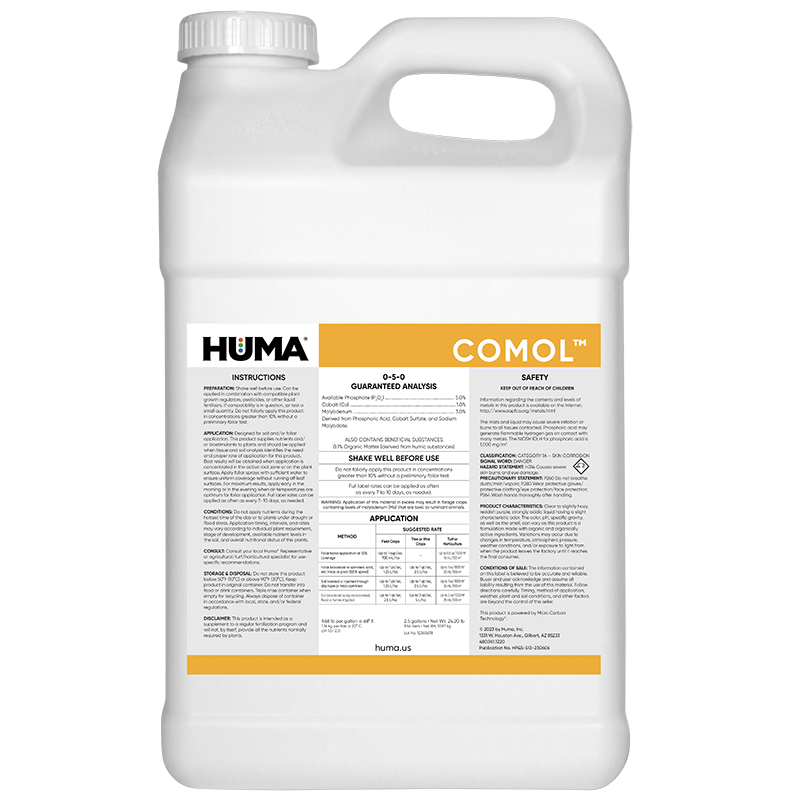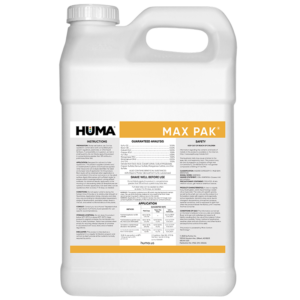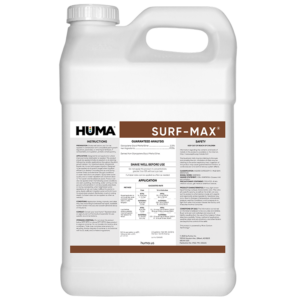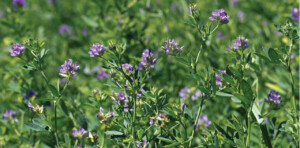COMOL
Benefits of Use:
- May be applied with Huma® Vitol® for a foliar nutrient balance for most crops to overcome stresses caused by severe weather or herbicide and pesticide residues
- Produces coenzymes necessary to convert nitrogen to amino acids for protein synthesis
- Stimulates natural production of enzymes that are required in ascorbic acid synthesis
- Buffers excessive ethylene concentrations in plant tissue
- Essential for nitrogen fixation in legumes (nitrogenase)
Deficiency Symptoms—When to Apply:
- In young plants, stunted growth or yellowish green leaves; in older leaves, light green followed by yellowing, drying, or shedding; often with abundant anthocyanins in the veins; chlorosis of entire leaf
- Shoots short, thin, growth upright and spindly, flowering reduced
- Premature fruit drop of crop; slow fruit development, smaller fruit size or not sufficiently colored
- Poor root system
- Plant stress from weather or chemical residues
- Limited nodule-forming bacteria in legumes
FAQs
Related Products
Related Case Studies

Huma® Ultra-Precision™ Blend Plus Root Dip Increases Strawberry Yields 30%
Objective The purpose of this research project was to evaluate how a special blend of fertilizer solution and a root dip made of Huma® products with Micro Carbon Technology® affect strawberry yield when compared with a control program of grower’s standard fertilizer and a competitor root dip product. Materials & Methods Strawberry cultivar San Andreas

Huma® Program Increases Peanut Yield Under Severe Conditions
Objective This field trial was conducted in order to compare peanut crop yields and return on investment (ROI) obtained when Huma® products were applied in various combinations in comparison with a grower standard program. Materials & Methods This trial on peanut (Arachis hypogaea, Var. GA-12Y) was conducted in Memphis, Tenn., in a randomized complete block

Effects of Huma® Products on N & P Stabilization in Sandy Soil
Objective To demonstrate the effects of Huma® products X-Tend®, Fertil Humus®, Fertil Soil®, and Zap® on the reduction of nitrogen and phosphorus leaching in Immokalee sandy soils. Background The leaching of nitrogen and phosphate fertilizers presents an ongoing problem in Florida soils. Agricultural amendments that reduce leaching when applied to soils or when mixed with
Related Blog Posts

This Week in Ag #9
Regenerative agriculture is not some passing fad. It’s now a movement. And it’s here to stay. How can we be sure? Just look at who’s driving it. Unlike well-intentioned predecessors, such as LISA (Low Input Sustainable Agriculture), regen ag has a financial benefactor: food companies. From lofty goals articulated by their CEOs to multi-million-dollar investments, consumer

This Week in Ag #2
Are we looking at a fertilizer shortage? Guess it depends on your definition. The availability of fertilizer isn’t a major concern in the US. It really wasn’t last year, either. As a good friend (who I consider to be among the best farmers in the country) told me last winter, “you can get it, it’s

What Determines a Farmer’s Crop Choice?
Ever wonder why farmers grow the crops they do? From soil type and climate to markets and processing plants, a wide range of factors influence what ends up in each field.










